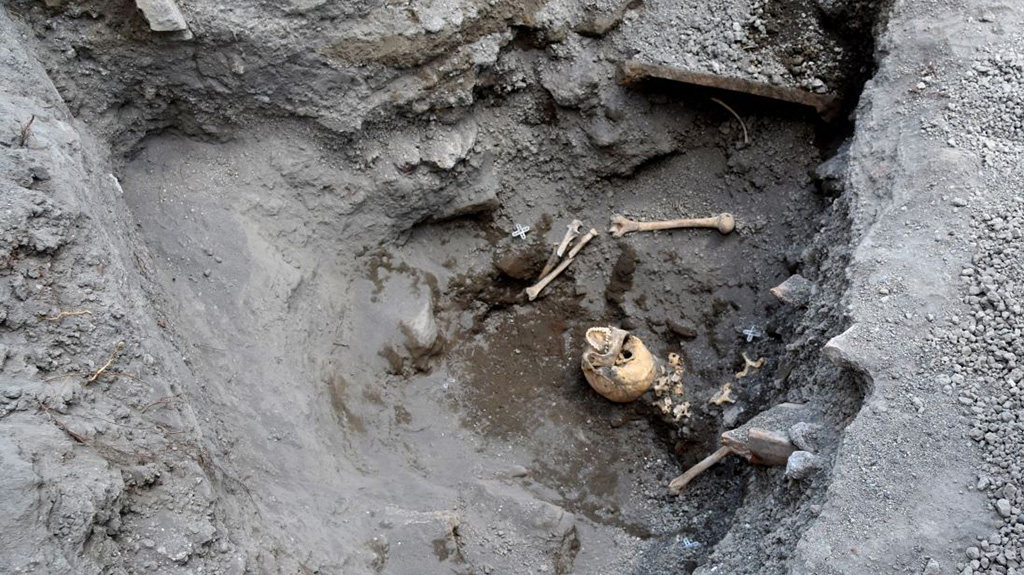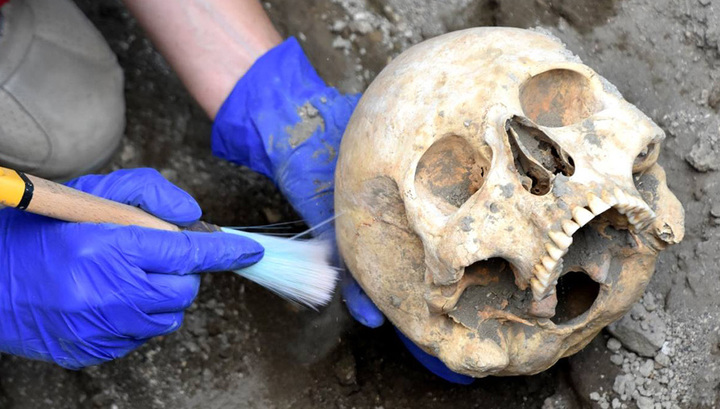Just a month ago, the whole world, competing in wit, commented on the photos of the sensational find in Pompeii: the remains of a man half-crushed by a giant rock mass. At a certain angle, the outstretched bone legs and stone instead of the head really looked somewhat comical, as if the photographer was shooting not documentary shots, but staged.

The remains of a man crushed by a stone block. Photo: Archaeological site of Pompeii
Everyone was in a hurry to give “hot news” about the find – from experts of the Archaeological Park of Pompeii to journalists and bloggers. Messages quickly appeared, quickly reprinted and retold, which inevitably led to errors and errors in the submission of information. However, in the end, all achieved their goals: interest in excavations in Regio V – the previously unexplored “fifth district” of Pompeii – rose to the maximum. The architectural rarities, colorful murals and even the skeletons of horses found in Pompeii this year did not have the same stimulating effect on the public as the stone-crushed skeleton of a lame man who moved too slowly and did not have time to leave the dying city in time.
We quote the interim conclusion of archaeologists from our first publication on the find (see “Skeleton that has become a meme, a zoo on frescoes and just balconies: new findings in Pompeii”):
“At one point a fragment of a stone support weighing 300 kg collapsed on the man – perhaps it was a lateral or transverse beam of the entrance aperture. The whole upper part of the body was crushed: the thorax was broken, the skull bones – even in the form of fragments – archaeologists have not been found.
Researchers believe that the stone block could collapse during a series of seismic shocks, or it was thrown out like a shell, by the monstrous force of the pyroclastic flow (the speed of a giant cloud of volcanic gases, ash and slag in Pompeii reached 100 km / h, the temperature was 300 ° C) . If the second assumption is true, there was no chance for the man to escape, even if the stone flew past: most of the victims of Vesuvius died at the moment when they were covered by a red-hot pyroclastic flow. ”
In early June, Italian archaeologists, in the wake of another find, described new details of the death of a man in August, 79 (see “Speed did not matter: new details of the death of horses and the lame man in Pompeii”):
“By clearing the remains for shipment to the laboratory, archaeologists noticed three coins lying between broken ribs. Further – more: in total under the bones were found 22 coins, 20 silver and 2 bronze. There were also fragments of a leather purse that had almost decayed for centuries: at the time of death, a man pressed him to his chest along with all the contents that embodied for him the hope of salvation and a new life in a new place. ”
No one doubted that the chest and head of a man were crushed by a direct hit of a giant block: this conclusion seemed obvious, judging by the relative location of the body and stone. However, in the comments of archaeologists there was uncertainty about the time of this event – after all, the stone could have fallen upon a dead man, who died, as the majority remained in the city, from the incandescent avalanche of pyroclastic flow.
In the evening of June 29 on the page of the Archaeological Park in Facebook there was another sensational message: the “crushed” skull, it seems, was found. Safe and sound.

The skull, (possibly) belonged to the deceased man. Photo: Archaeological site of Pompeii / Facebook
The skull and fragments of other bones were found in the pit next to the first find, far below the level of the “rest” of the body and the stone that fell on it. Now no one will undertake to state with full certainty who owns the skull-for this, laboratory research will be needed, but the likelihood that the skull really belongs to the crushed person is very high. The possible cause of this anomaly is the trench, excavated here by the first researchers of Pompeii in the XVIII century, even under the Bourbons. This could cause a collapse of the upper body of the deceased, including the head. The stratigraphy of the excavation site, therefore, also disrupted. The only thing archaeologists are sure of now is the stone block of its location has not changed.

Yama, in which a separately lying skull was found. Photo: Archaeological site of Pompeii / Facebook
In the light of this unexpected finding, archaeologists concluded that the lame man was not a victim of catastrophic bad luck. He was killed not by a direct hit of a stone block, but by the most common cause of the death of citizens on August 24, 79: he “welded” in a 300-degree heat pyroclastic flow. When a stone chip fell on the body, the man was already dead.

Anthropologist Valeria Amoretto clears the skull, (possibly) belonging to the crushed man. Photo: Archaeological site of Pompeii / Facebook











